Explore Groundwater Levels at the Nebraska State Fair
Visit the Outdoor Learning Area, located east of the Raising Nebraska Building, while you enjoy the Nebraska State Fair! This green oasis offers not only a place to relax but also an educational experience about our precious natural resources and groundwater. A recent addition to the site is a which reaches a depth of 55-foot deep monitoring well, funded by the Nebraska Well Drillers Association and dug by Downey Drilling. Thanks to a generous donation from Seim Ag Technology, a monitoring system has been installed to provide real-time data on groundwater levels.
Step inside the Raising Nebraska Building and check out the kiosk near the elevated map. Here, you can view year-round groundwater levels and observe how they fluctuate at this site. Read Water Level
Grand Island Groundwater Guardian’s Outdoor Learning Area
The Grand Island Groundwater Guardian’s Outdoor Learning Area (OLA) is located at the Nebraska State Fairgrounds in Grand Island, Nebraska. This site is designed to provide an attractive green space while also offering education on groundwater. The OLA is a stimulating place for play, learning, and environmental education, particularly water education. Local educators are invited to use the area to teach students about water conservation, butterfly migration, pollinators, and native plants and grasses. The OLA is accessible year-round to the public and offers educators an educational and leisurely place to enjoy nature.
Public Education
The OLA aims to educate the public about:
- Water quantity, water quality, and groundwater stewardship.
- Various types of vegetation and water use in Nebraska.
- Natural filtration techniques.
- Efficient water use.
- Native birds, wildlife, and pollinators.
- Native plants and urban native mixed prairie.
FEATURES
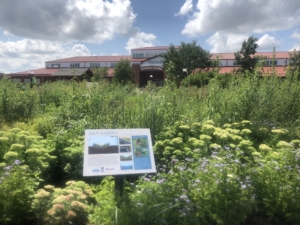 Rain Garden
Rain Garden
The rain garden is a planted depression that allows rainwater runoff to be absorbed from impervious urban areas like roofs, driveways, walkways, parking lots, and compacted lawn areas. It educates visitors on reducing rain runoff by allowing stormwater to soak into the ground, rather than flowing into storm drains and surface waters, which can cause erosion, water pollution, flooding, and diminished groundwater. Native plants in the rain garden demonstrate that little to no fertilizer is necessary for a vibrant flower garden and that these plants are more tolerant of local climate, soil, and water conditions. The garden includes wetland edge vegetation such as wildflowers, sedges, rushes, ferns, shrubs, and small trees. Signage educates the public on how water filters through soil layers before entering the groundwater system and how root systems enhance infiltration, provide moisture redistribution, and sustain diverse microbial populations involved in biofiltration. The rain garden's plants also return water vapor to the atmosphere through transpiration. The site attracts wildlife, including birds, rabbits, butterflies, and other pollinators.
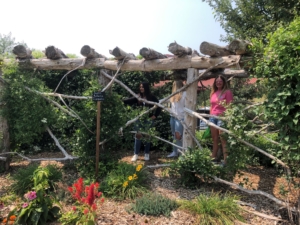 Kids Tunnel & Teepee
Kids Tunnel & Teepee
Installed in 2013, these natural play features use flowering vines to cover the structure, creating a space for children to play and learn about plants, vines, and shade.
Bioswale
The bioswale is a landscape element designed to remove silt and pollution from surface runoff water. Located near a swaled drainage area (sidewalk), it features gently sloped sides filled with vegetation to create a flow path for excess water. The bioswale is designed to maximize the time water spends in the swale, aiding in trapping pollutants and silt.
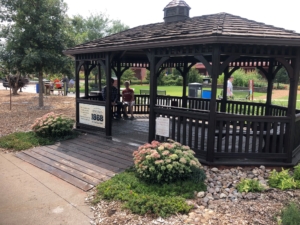 Gazebo
Gazebo
The Grand Island Izaak Walton League donated a gazebo to the site. It provides seating for a classroom setting and a comfortable resting area for the public to enjoy the site. The structure includes rain gutters and a rain barrel to educate the public about water conservation.
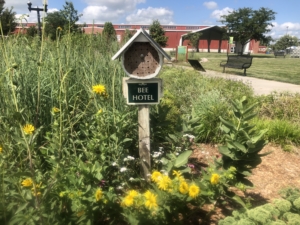 Bee Hotel
Bee Hotel
The bee hotel provides essential nesting homes for solitary bees, which do not swarm or have a hive like honeybees and wasps. Solitary bees are excellent pollinators. Signage educates visitors on how bees and other pollinators help crops and plant communities to remain healthy and productive.
Prairie Restoration
The native prairie area combines a natural play feature with an alternative to turf cover. Prairie grass and forb roots help add structure to the soil and improve water infiltration over time. A path through the area allows visitors to see and identify plants and grasses up close.
YOUR CONTACT: Marcia Lee | lee@cpnrd.org | (308) 395-7551
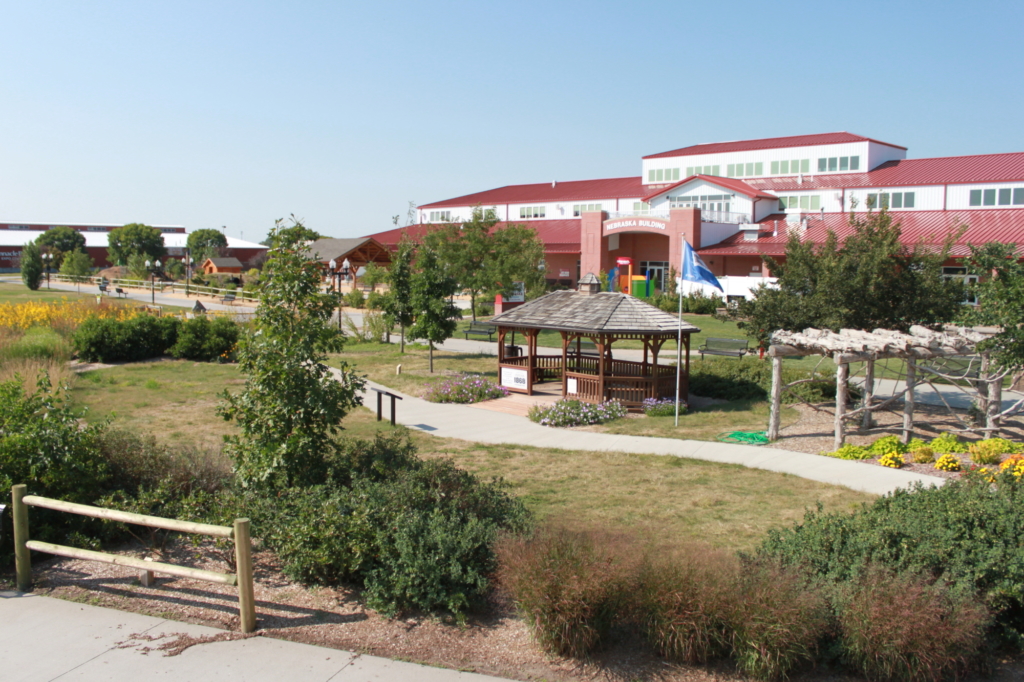
IMPLEMENTATION The Grand Island Groundwater Guardian Team realized the potential of educating thousands of people about groundwater and its uses when we received 1st place through a national online contest held by Rain Bird: The Intelligent Use of Water Awards! That first place prize was $10,000 to implement features such as a rain garden, bioswale, gazebo, cedar tunnel, prairie maze, and trees. The project received 30,597 votes; about 1,000 more than any other project in the country.
AWARD The Grand Island Groundwater Guardian Team received a Community Beautification Award from the Hall County Regional  Planning Commission in October 2016. The award recognizes the Outdoor Learning Area as a place to beautify and improve the community.
Planning Commission in October 2016. The award recognizes the Outdoor Learning Area as a place to beautify and improve the community.
GROUNDBREAKING A groundbreaking ceremony was held on Friday, August 31, 2012. Jack Vetter, Vetter Health Systems, was a guest at the groundbreaking ceremony. Vetter matched the online contest that the Guardians won from Rain Bird: The Intelligent Use of Water Awards.
FUNDING After receiving the initial $10,000 from the online voting, the Guardians also acquired $47,500 in other grants from Vetter Health Services, Water For The West, Waterwise (NE Environmental Trust), Fonner Park, City of Grand Island and Nebraska Department of Environmental Quality. The project would not have been possible without the support of Fonner Park, the Nebraska State Fair. The Grand Island Youth Leadership and Roots & Shoots have donated plants and their time to enhance the site.
GWG TEAM The Grand Island Groundwater Guardian Team is a local volunteer group whose purpose is to educate the public about the importance of groundwater. Members: Roger Andrews, retired-Bureau of Reclamation; Larry Cast, retired-Bureau of Reclamation; Duane Woodward, retired hydrologist-Central Platte NRD; Julie Frandsen, Grand Island Utilities Dept; Elizabeth Killinger, UNL Extension Educator; Mike Kube, retired-Bureau of Reclamation; Ken Gnadt, former Mayor of City of Grand Island; Marcia Lee, Central Platte Natural Resources District; Gary Mader, retired-Grand Island Utilities Department; Denise McGovern-Gallagher, Grand Island Area Clean Community System; Milt Moravek, Retired-Central Platte Natural Resources District; Patsy Steenson- Retired Elementary Educator. OLA Project Director: Gary Mader
For information on activities available at the Outdoor Learning Area, or information on getting involved in the Groundwater Guardian project contact: Marcia Lee or Elizabeth Killinger
Would you like to be a member of the Groundwater Guardian Team?
We're actively looking for new members ideas on youth and public educational activities to understand the importance of groundwater in our daily lives. If you like working outside, we're also looking for assistance at the Outdoor Learning Area (OLA), located at the Nebraska State Fairgrounds.
HOW YOU CAN HELP
* The Team meets two times a year in Grand Island to discuss upcoming plans and events.
* 2-3 workdays throughout the year to maintain the Outdoor Learning Area.
* Education activities at the Nebraska Children's Groundwater Festival, activities for local schools & community events
The Grand Island Groundwater Guardian Team is a 501(c)3 local nonprofit group that provides groundwater education to area youth, participates in community events, and updates and maintains the Outdoor Learning Area for the public. If you would like to donate to allow the Groundwater Guardians continue to offer these activities, contact the Grand Island Community Foundation at 308-381-7767. EIN#: 47-6032570
OUR GOALS
- To educate the public about water quantity, water quality and stewardship of water resources.
- To educate the public on various types of vegetation and water uses across the state of Nebraska.
- To educate the public on natural filtration techniques.
- To educate the public on efficient water use.
- To educate the public about the Ogallala Aquifer.
Why? Increasing numbers of both children and adults are losing contact with the natural world. Reasons include the rapid growth of domestic air-conditioning since the 1950s; apprehensive parents who keep their children close to home; state-mandated curricula that do not allow time for study outdoors; and the overly-structured, hurried lifestyle of many people today.
 Rain Garden: The rain garden is a planted depression that allows rainwater runoff to be absorbed from impervious urban areas like roofs, driveways, walkways, parking lots, and compacted lawn areas. The public would be educated on how this reduces rain runoff by allowing stormwater to soak into the ground, as opposed to flowing into storm drains and surface waters which causes erosion, water pollution, flooding, and diminished groundwater. It will be designed for Nebraska-specific soils and climate. Native plants from all areas of Nebraska have been used because they don’t require fertilizer and are more tolerant of the local climate, soil, and water conditions. They also attract local wildlife such as native birds and butterflies. The plants include a selection of wetland edge vegetation, such as wildflowers, sedges, rushes, ferns, shrubs and small trees— will take up excess water flowing into the rain garden. Water filters through soil layers before entering the groundwater system. The site shows how the root systems enhance infiltration, maintain or even augment soil permeability, provide moisture redistribution, and sustain diverse microbial populations involved in biofiltration. Also, through the process of transpiration, rain garden plants return water vapor to the atmosphere.
Rain Garden: The rain garden is a planted depression that allows rainwater runoff to be absorbed from impervious urban areas like roofs, driveways, walkways, parking lots, and compacted lawn areas. The public would be educated on how this reduces rain runoff by allowing stormwater to soak into the ground, as opposed to flowing into storm drains and surface waters which causes erosion, water pollution, flooding, and diminished groundwater. It will be designed for Nebraska-specific soils and climate. Native plants from all areas of Nebraska have been used because they don’t require fertilizer and are more tolerant of the local climate, soil, and water conditions. They also attract local wildlife such as native birds and butterflies. The plants include a selection of wetland edge vegetation, such as wildflowers, sedges, rushes, ferns, shrubs and small trees— will take up excess water flowing into the rain garden. Water filters through soil layers before entering the groundwater system. The site shows how the root systems enhance infiltration, maintain or even augment soil permeability, provide moisture redistribution, and sustain diverse microbial populations involved in biofiltration. Also, through the process of transpiration, rain garden plants return water vapor to the atmosphere.
Bioswale: This landscape element is designed to remove silt and pollution from surface runoff water. The location is near a swaled drainage area (a sidewalk) and includes gently sloped sides filled with vegetation, compost, and riprap. The water’s flow path, along with the wide and shallow ditch, is designed to maximize the time water spends in the swale, which aids the trapping of pollutants and silt.
Gazebo: The gazebo provides seating for a classroom setting and resting area. The structure includes gutters and a rain barrel to educate 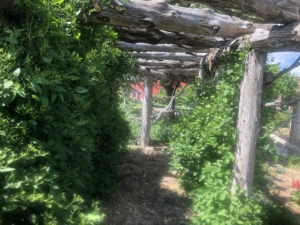 about gutters, rain barrels, and grass pavers.
about gutters, rain barrels, and grass pavers.
Kids Tunnel: This natural play feature was installed in July 2013 and uses flowering vines to cover the structure, creating a space for children to play and learn about plants, vines, and shade.
 Bee Hotel: The bee hotel provides essential nesting homes for solitary bees. These bees don't swarm or have a hive like the more well-known honeybees and wasps. Solitary bees are excellent pollinators. They pollinate our crops and ensure that plant communities are healthy and productive.
Bee Hotel: The bee hotel provides essential nesting homes for solitary bees. These bees don't swarm or have a hive like the more well-known honeybees and wasps. Solitary bees are excellent pollinators. They pollinate our crops and ensure that plant communities are healthy and productive.
Prairie Restoration: This area was planted by the Prairie Plains Resources Institute. The prairie path combines the natural play feature with a need to cover a low area on the site with something other than turf. The prairie grass and forb roots help add structure to the soil and improve water infiltration over time. Simply mowing a path through the area allows the public to experience running through tall prairie grasses. The restoration process will take years to complete.
4-H Building: During the State Fair, the 4-H building has several events. The remainder of the year, the building is utilized as a sports field house with baseball & softball cages, basketball courts, volleyball courts, soccer fields, and kids play area.
Raising Nebraska Building: This 50,000 square-foot building is just west of the outdoor learning area. It is two stories high with exhibition space on the ground floor and the Nebraska State Fair administrative offices on the second floor. It also features a museum area with information and artifacts from the past 144 years of the fair. The Department of Agriculture and the Nebraska Game & Parks Commission share the lower floor with meeting space available on the top floor. The Dept. of Agriculture’s interactive, technology-based displays promote agriculture in Nebraska and is available for use year-round. The display has been described as a Smithsonian-type display with simulators and videos.
Family Fun Center: During the State Fair, the Family Fun Activity Center is located under a large tent in the Family Fun Activity Center and provides all-day games, sanctioned games & competitions, a daily food eating contest, Make-and-Take activities, and much more for children of all ages. Butterfly adventures, which is an educational environment where people can interact with butterflies of many different species will be held daily in the Family Fun Zone, as well as The Pirates of the Colombian Caribbean Aerial High Wire Thrill Show, which is a daily grounds entertainment act with multiple showings a day.
-
Main Office
- 215 Kaufman Ave, Grand Island, NE 68803 308-385-6282
-
Cozad Office
- 75887 Road 414, Cozad, NE 69130 308-380-8943
-
NRCS Field Offices (Ext. 3)
- Central City 308-946-3035
- Kearney 308-237-3118
- Grand Island 308-395-8586
- Lexington 308-324-6314
- Osceola 402-747-2461




